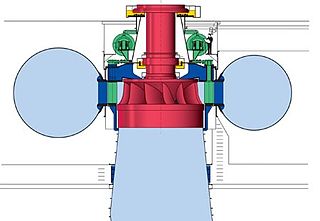
Alternating current (AC) is an electric current which periodically reverses direction, in contrast to direct current (DC) which flows only in one direction. Alternating current is the form in which electric power is delivered to businesses and residences, and it is the form of electrical energy that consumers typically use when they plug kitchen appliances, televisions, fans and electric lamps into a wall socket. A common source of DC power is a battery cell in a flashlight. The abbreviations AC and DC are often used to mean simply alternating and direct, as when they modify current or voltage.

Electric power distribution is the final stage in the delivery of electric power; it carries electricity from the transmission system to individual consumers. Distribution substations connect to the transmission system and lower the transmission voltage to medium voltage ranging between 2 kV and 35 kV with the use of transformers. Primary distribution lines carry this medium voltage power to distribution transformers located near the customer's premises. Distribution transformers again lower the voltage to the utilization voltage used by lighting, industrial equipment or household appliances. Often several customers are supplied from one transformer through secondary distribution lines. Commercial and residential customers are connected to the secondary distribution lines through service drops. Customers demanding a much larger amount of power may be connected directly to the primary distribution level or the subtransmission level.

A power inverter, or inverter, is an electronic device or circuitry that changes direct current (DC) to alternating current (AC).

Power electronics is the application of solid-state electronics to the control and conversion of electric power.
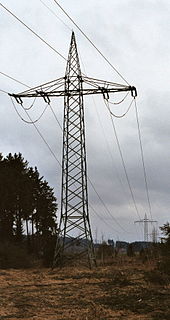
A traction network or traction power network is an electricity grid for the supply of electrified rail networks. The installation of a separate traction network generally is only done if the railway in question uses alternating current (AC) with a frequency lower than that of the national grid, such as in Germany, Austria and Switzerland.

A traction substation, traction current converter plant or traction power substation (TPSS) is an electrical substation that converts electric power from the form provided by the electrical power industry for public utility service to an appropriate voltage, current type and frequency to supply railways, trams (streetcars) or trolleybuses with traction current.

Railway electrification systems using alternating current (AC) at 15 kilovolts (kV) and 16.7 Hertz (Hz) are used on transport railways in Germany, Austria, Switzerland, Sweden, and Norway. The high voltage enables high power transmission with the lower frequency reducing the losses of the traction motors that were available at the beginning of the 20th century. Railway electrification in late 20th century tends to use 25 kV, 50 Hz AC systems which has become the preferred standard for new railway electrifications but extensions of the existing 15 kV networks are not completely unlikely. In particular, the Gotthard Base Tunnel still uses 15 kV, 16.7 Hz electrification.
EnBW Energie Baden-Württemberg AG, or simply EnBW, is a publicly traded electric utilities company headquartered in Karlsruhe, Germany. As its name indicates, it is based in and primarily serves the German state of Baden-Württemberg.
A phase converter is a device that converts electric power provided as single phase to multiple phase or vice versa. The majority of phase converters are used to produce three-phase electric power from a single-phase source, thus allowing the operation of three-phase equipment at a site that only has single-phase electrical service. Phase converters are used where three-phase service is not available from the utility, or is too costly to install due to a remote location. A utility will generally charge a higher fee for a three-phase service because of the extra equipment for transformers and metering and the extra transmission wire.
The Stellenbosch UNiversity SATellite is the first miniaturized satellite designed and manufactured in South Africa. It was launched aboard a Delta II rocket from the Vandenberg Air Force Base on 23 February 1999. Sunsat was built by post-graduate engineering students at the University of Stellenbosch. Its AMSAT designation was SO-35.

Folsom Powerhouse State Historic Park is a historical site preserving an 1895 alternating current (AC) hydroelectric power station—one of the first in the United States.
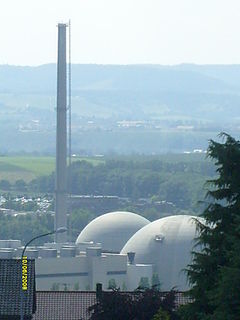
Neckarwestheim Nuclear Power Station is a nuclear power plant in Neckarwestheim, Germany, sometimes abbreviated GKN, operated by EnBW Kernkraft GmbH.
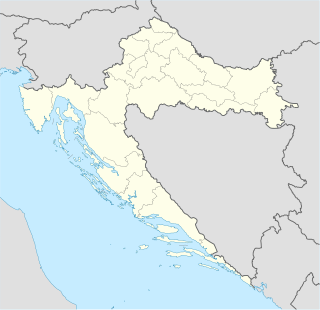
Jaruga Hydroelectric Power Plant is a hydroelectric power plant on river Krka, located in Šibenik-Knin county, in central Dalmatia, Croatia.

Cos Cob Power Station was a historic power station near the Metro North Railroad tracks, the Mianus River and Sound Shore Drive in the Cos Cob area of Greenwich, Connecticut.

Kjofossen Power Station is a hydroelectric power plant at Sogn og Fjordane built during World War II. Part of its power is used as railway traction current, i.e. single-phase electric power at 16 2/3 hertz, fed directly into the overhead wire of the railway to Bergen. The only other power station in Norway to produce traction current is Hakavik Power Station.

Porjus power station is one of the oldest and largest power plants in Sweden, situated near Porjus. It was built 1910-1915 and has a power of 480 MW. Besides three-phase AC, the plant originally also generated single phase 15 Hz AC for railway traction and hence, two single-phase 80 kV power lines ran along the Iron Ore Line Malmbanan where it was transformed down to 16 kV in substations. However this system was later abandoned in favor of rotary converter stations. The original machines for single phase AC were subsequently scrapped.

Germany's electrical grid is part of the Synchronous grid of Continental Europe. In 2018, Germany produced 540 TWh of electricity of which 40% was from renewable energy sources, 38% from coal, and 8% from natural gas.

The Norwegian railway network consists of 2,552 kilometers (1,586 mi) of electrified railway lines, constituting 62% of the Norwegian National Rail Administration's 4,114 kilometers (2,556 mi) of line. In 2008, electric traction accounted for 90% of the passenger kilometers, 93% of the tonne kilometers and 74% of the energy consumption of all trains running in Norway, with the rest being accounted for by diesel traction.
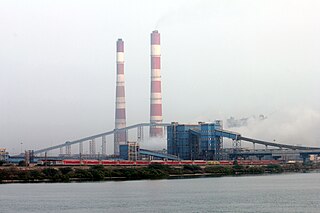
Vallur Thermal Power Station is a power plant located in Athipattu Pudunagar, Vallur in Thiruvallur district, North Chennai, India. The power plant is operated by NTPC Tamil Nadu Energy Company Limited, a joint venture between NTPC Limited and TANGEDCO and has three units with 500 MW each.

